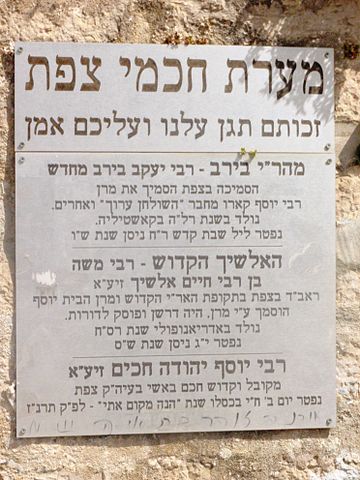
Plaque outside the burial cave of Jacob Berab, Safed, Israel | (c) en.wikipedia.org/wiki/Jacob_Berab
The great patchwork of history involves a lot of individual players, from kings and queens, to scholars and soldiers, and even just regular people in the right place at the right time. Our Glatt Kosher Tours through Iberia have been some of the most memorable experiences that we’ve had. Iberia was the home of many notable Jewish individuals and was the site of many historic events and eras.
The 1492 Expulsion was a great blow to Sephardic history and heritage, but even then, there were many parts of Jewish culture that persisted. One of the lost traditions of Judaism was the classical Semikahah, a kind of rabbinical ordination that could form the Sanhendrin, which, during that time, was long out of practice. Yaakov Beirav sought to change that.
The Story of Yaakov
Yaakov Beirav, or Jacob Berab, whose family name was Marmaran, was born in Maqueda, Castillan Spain in 1474. When he was eighteen years old, the Expulsion of Spanish Jews forced him to flee. He eventually ended up in Tlemcen, Algeria, where he so impressed the local Jewish community with his knowledge of the Law that they accepted him as their rabbi. He would travel a bit more during his life, visiting Jerusalem, living in Damascus, becoming a rabbi in Cairo and finally settling in Safed.
A few decades after the Expulsion, many crypto-Jews, who hid their Judaism by pretending to be Christian or another faith, began to slowly return to their ancestral religion. This provided a halachic issue for some rabbis, who believed that a Sanhendrin (formed from a classical Semikhah) was needed to carry out the punishment of makkot for their sake.
Yaakov Beirav sought to revive the classical Semikhah for several reasons, including the one above. Another was the belief that it would draw the time of the Messiah closer, and that such a decision could strengthen Jewish resolve in those troubling times. He would later be ordained by twenty-five rabbis, and then he would later ordain a few others under the authority given to him. Among them was Josef Caro.
Unfortunately for Yaakov, he attempted to ordain one of his opponents, the rabbi Levi ibn Habib, as a token of goodwill. The latter did not accept this, and their conflict would cause enough strife and controversy for Yaakov’s attempts at reviving the semichah to lose momentum. Yaakov Beirav died on April 3, 1546.
Ordination and the Future
While his efforts did not establish a Sanhedrin in the long run, Yaakov Beirav influenced the course of Jewish history in his own way. He ordained Josef Caro,who would write down the Shulchan Aruch. His attempt would inspire more modern-day efforts to reestablish the sanhedrin, such as the one in 2004.
Whenever we go on jewish trips, we always make sure to enrich our cruise-goers with the history of the locales we visit. On a future visit to Spain, let us remember the efforts of Yaakov Beirav, and how his influence affected the generations to come.
